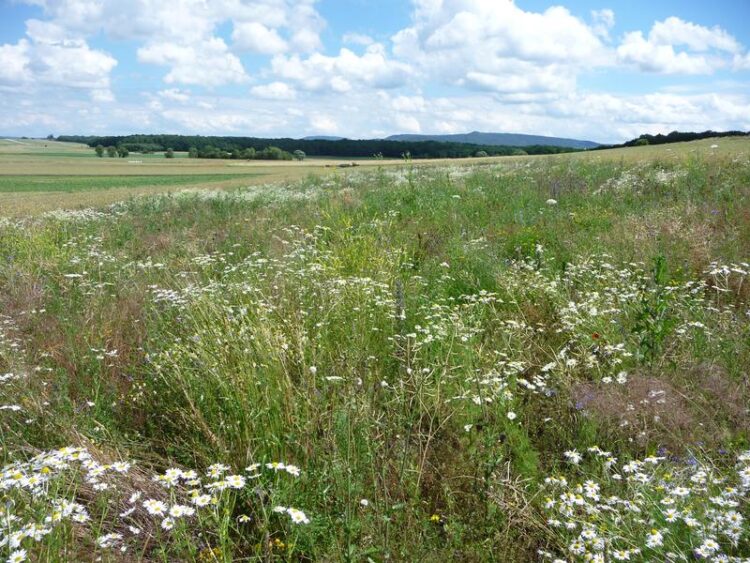Optimally Promoting Biodiversity in Agricultural Landscapes

Bei der Artenvielfalt spielt das Alter der Blühfläche eine wichtige Rolle. Hier ein junges Habitat.
Fabian Bötzl / Universität Würzburg
In an exceptionally broad and elaborate study, biologists from the University of Würzburg investigated the biodiversity of flowering fields planted as part of agri-environmental schemes.
Due to modern agriculture, biodiversity across many species groups is in decline. Over the last three decades, attempts have been made to counteract this with agri-environmental schemes at various levels – from the national federal state to EU-wide programmes. Not only out of appreciation of nature, but also because many species fulfil important functions for agriculture itself: some pollinate crops, others regulate pest populations.
Publication in PNAS
One of the measures promoted in the schemes is the creation of flowering fields. “However, it is currently not conclusively known whether and to what extent these habitats achieve the desired effect on biodiversity,” says Professor Ingolf Steffan-Dewenter. In order to provide more clarity, the head of the Chair for Animal Ecology and Tropical Biology at Julius-Maximilians-Universität Würzburg (JMU) in Bavaria, Germany, launched a large-scale field study in 2016. The results have now been published in the scientific journal “Proceedings of the National Academy of Sciences of the United States of America” (PNAS).
The biologists investigated the species composition of different types of flowering fields in agricultural landscapes in northern Lower Franconia. As a benchmark, they used the semi-natural calcareous grasslands that can be found in this region. These usually protected flowering habitats are known for their high species diversity.
Almost 55,000 specimens identified
“Our approach differs from previous scientific studies in this field in some essential respects,” explains Fabian Bötzl, the lead author of the Würzburg study. First, there is the extent of the species groups considered: A total of twelve taxonomic groups were studied – from vascular plants to cicadas, bees, flies, butterflies and beetles to birds. In three years of data collection in the field and about another year of laboratory analyses, the researchers identified almost 55,000 specimens that could be assigned to 3187 taxa.
Temporal continuity as an important factor
Secondly, they included the temporal continuity of the diverse flowering fields. “This means that we – unlike many previous studies – took into account the respective age of the flowering fields and their history of use,” explains JMU professor Jochen Krauss, co-author of the study.
The results underpin that diversity increases in most taxonomic groups with the temporal continuity of the habitats. For example, there are only five to six species of grasshoppers on newly established flowering fields in the first year, which then increase over time to the approximately 15 species of the calcareous grasslands used as a reference.
Young areas also have their advantages
As a consequence, should – in terms of species conservation – the rule be ‘the older the better’? “It is not that simple, as with flowering fields getting older, the composition and the respective number of species also change,” Bötzl explains. “For some species, such as ground beetles, which play an important role in pest control in adjacent agricultural areas, young habitats are more advantageous. Their species number decreases over time.”
Another result of the study: the size of the flowering fields and their surrounding landscape – whether rather monotonous or diverse – have only minor effects on the development of species diversity.
It is the mix that counts
In addition to the scientific community, the planning authorities responsible for agri-environmental programmes can also be potential addressees of the Würzburg research results. The following messages can be derived for them: There is no ideal type of flowering field that supports all species equally well. For the aim of protecting as many animal and plant species as possible, well-distributed flowering fields of different ages are recommended in the agricultural landscape.
Wissenschaftliche Ansprechpartner:
Fabian Bötzl, Biocentre of the University of Würzburg, T +49 931 31-88795, fabian.boetzl@uni-wuerzburg.de
Originalpublikation:
Boetzl FA, Krauss J, Heinze J, Hoffmann H, Juffa J, König S, Krimmer E, Prante M, Martin EA, Holzschuh A, Steffan-Dewenter I (2021) A multi-taxa assessment of the effectiveness of agri-environmental schemes for biodiversity management. PNAS, DOI 10.1073/pnas.2016038118
Media Contact
All latest news from the category: Agricultural and Forestry Science
Newest articles

Largest magnetic anisotropy of a molecule measured at BESSY II
At the Berlin synchrotron radiation source BESSY II, the largest magnetic anisotropy of a single molecule ever measured experimentally has been determined. The larger this anisotropy is, the better a…

Breaking boundaries: Researchers isolate quantum coherence in classical light systems
LSU quantum researchers uncover hidden quantum behaviors within classical light, which could make quantum technologies robust. Understanding the boundary between classical and quantum physics has long been a central question…

MRI-first strategy for prostate cancer detection proves to be safe
Active monitoring is a sufficiently safe option when prostate MRI findings are negative. There are several strategies for the early detection of prostate cancer. The first step is often a…



